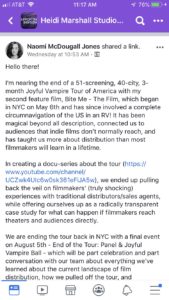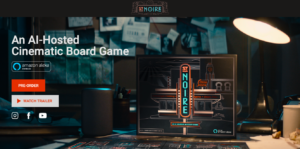Well folks, “below the fold” is the news for this week – and for awhile. As my longer-term readers know, I take every August off for a writing and social media vacation. Every year since 2010, which means for ten years now (!!!), I’ve unplugged from the web – except for work – for the entire month. I don’t check blogs, read any online news, f-around with Instagram, Facebook, Twitter, or any other social media. I am not lucky enough to be able to completely unplug – I do take emails from clients and other general work for the first two weeks of August, but then I actually stop checking emails for the latter half of the month and am completely off-line through Labor Day.
It’s the best thing I’ve ever done. And it’s led me to decrease my time on Facebook and lave Twitter completely; and I barely use Instagram anymore, even outside of August. I go on every now and then to post this newsletter, and to do some client work, but I don’t check updates or get lost in the endless scroll. About a year ago, I decided that even if I was staring at the wall, that was better than scrolling the feed. I was more likely to think a creative thought, or not have a negative one, if I just avoid the herd online. And you know what – I haven’t missed any important news, just some baby photos. I’ve taken that extra time on my hands to write – here at this newsletter, and in my own creative writing, and I am much happier for it, and the feedback and subscriber rates have been much improved here as a result.
I highly recommend considering a social media/online sabbatical for everyone. We’re all too connected to our phones, to the feed, to news on what crap Trump has done today, to what everyone thinks about it, and to “keeping up” with all the news in our industry (whatever your industry may be). It’s not healthy.
Or more poetically – here’s Kate Tempest on this same subject on her new album, The Book of Traps and Lessons (which I highly recommend):
“Stroke the phone screen with your thumb like
A mother
Trying to wipe clean the face of her only
Child
That blemish that black dot that will not come
Clean
The first sign of the
Plague
Absorb the ache of all your
Friends
And sleep with the light in your brain burning
UV all night”
The D-Word, a great online documentary community board, has a special topic running on mental health and filmmakers right now. I’m not reading it – because I stopped participating in bulletin boards and email lists ten years ago as well – but I hear it’s going pretty well. If you must connect this August, I recommend perusing the comments and advice being given over there.
In the meantime, I’ll be swimming. I do this almost every day throughout the year, but focus on getting in more laps during August (most years, I even do an open-water race, but not this year). I picked it up again around the time I started my August internet sabbaticals, and it’s been great for my health – especially my mental health.
This weekend, the NYT ran an Op-Ed by a psychiatrist about what he’s learned about life and happiness from swimming, and it resonated for me. He writes about how he was always disappointed that he couldn’t swim faster, until his coach told him to focus on technique and the speed would follow. As Dr. Richard Friedman wrote in the NYT, “We all wanted to swim faster and the more hysterically we tried, the more speed escaped us. The same goes for happiness. Everyone wants to be happy, yet the more directly we pursue happiness, the more elusive it becomes.”
I think many people use social media and obsessively search the net, in some elusive search for happiness and meaning, and all it does is make you obsessed with the scroll, when happiness and meaning is all around you – if you stop searching for it, and just get offline and actually live. I need to do this more, still, but August is where I focus on this technique. Friedman concludes, and I will to, as follows: “In the end, happiness is a side effect of living well — just like speed can be the result of excellent swimming technique. Now, if you’ll excuse me, I’m off to the pool.”

WHAT I’M READING: FILM & STREAMING
Chinese vertical dramas made for phone viewing show the future of mobile video – (h/t Sundance Creative Distribution): China is always light-years ahead of us in the US on tech trends, and we see it here again with the adoption of more vertical formats for scripted shows, meant for viewing on mobile. With consumers switching from TV screens to mobile, this trend will continue. Quibi is going full bore with this as well, reports Digiday – they are requiring producers to shoot twice as much footage, so they can deliver every program in both vertical and horizontal formats. I know my auteur friends are puking now, but this trend might be here to stay. I say “might-be” because I hear a rumor that PornHub hasn’t adopted this format, and porn always leads the way for online video.
Average US Time spent with Mobile in 2019 Has Increased – EMarketer, in a report from June, shows that time on mobile now surpasses time on TV for the first time ever – a pretty significant screen shift.
How Netflix is changing the future of Movie Theatres – “Theatres have to fight against Netflix by becoming more like Netflix” says Forbes, with a good run-down of the bigger theater chain’s subscription plans, and how they might use the data they can now access for smarter movie marketing.
BITE ME: End of the Road for the Joyful Vampire Tour, On August 5th the Joyful Vampire tour comes to NYC, it’s the end of their multi-city DIY distribution tour, and the promise to share the numbers, be transparent, teach some lessons-learned about film distribution and have a party. I’m late to this particular show, but Ben in my office sent me these screen-shots when the tour hit his social feed and after perusing their materials, I was impressed:


Every few years some plucky filmmakers make a film that doesn’t get picked up and decide to go on tour. The late Sarah Jacobson did this with Mary Jane’s Not a Virgin Anymore back in 1997, and these filmmakers are following in her footsteps. It’s a lot of work to put together a film tour, but sometimes, it’s your only viable option.
You can watch their docu-series about the tour here, and the trailer is here. I have no idea if the film is any good, but I applaud their efforts.
WHAT I’M READING & THINKING: BRANDED CONTENT
This week was BrandStorytelling’s Elevate Conference. You can get a taste of what takes place by reading their newsletter, online here. The team puts on one of the best events I’ve ever attended, and if you are remotely working in this sector, it should be on your to-do list.

A lot of the conference topics are about learning who is doing what, discovering some new ideas and best practices. But there was a big emphasis this year on impact entertainment – brands trying to make a difference via social impact media, and how to do that. Another hot topic was measurement – most people there don’t even trust the viewership data they are getting, don’t know what other metrics they should be looking into and there’s a general consensus that some standardization needs to take place. There was a bit of future-casting – looking into what’s next, what we’re missing and what new forms story-telling might take.
Another much talked-about event was an inspiring interview with Debbie Sterling the founder of GoldieBlox. I am not in the demographic, but if you want to be inspired, you’d be hard-pressed to find a better story than how she defied all the naysayers and built a smart toy/tool to stimulate STEM interest among young girls, and “disrupt the pink aisle.” Starting with a successful Kickstarter, then hard work and brand building and later, some investment, she’s made a super successful brand.
But that wasn’t enough – as she sought to move into content, she took meetings with every studio, agency and broadcaster and they all turned her down. So once again, she and her team took destiny into their own hands and started what has become a super popular online video brand, with a GoldieBlox character, that has built a large and loyal audience of young girls who love STEM topics. I go into this for so long here because it’s a lesson for any filmmaker or aspiring entrepreneur, or brand going into content – don’t try to work with a system that isn’t built to try to help you. Break down the walls. As Mark Duplass has said – don’t wait for the cavalry to help you – you are the cavalry. Follow Sterling’s lead and just build cool shit and, if you do it right and get a little bit of luck – audiences will find you, with no one else’s help.
One thing that was not discussed, but kept coming into my mind – it’s been said that advertising is becoming a tax on the poor. Those who can afford it are paying for SVOD services and getting rid of interruptive advertising, but a large mass of people are telling surveyers that they want to pay less than $27 a month for their subscriptions, and for many, even much less – so they are moving to Ad-supported platforms (AVOD).
At the same time, there’s a huge war going on for eyeballs in the SVOD space, and that’s driving up costs for production and (in general) quality. Add to this the investments Quibi is making in the short form space (they will have both AVOD and SVOD options). What I see happening is a general raising of the bar, and that will mean that brands – and filmmakers – have to step up to another level in their budgets and quality to have any change of getting onto SVOD. And in many cases, those platforms will be very selective and curatorial.
So what happens if your brand wants to reach the “upper class” of consumers? Will you be priced or quality-filtered out of their feeds? And if you’re more broadly looking at the 90%, how does non-interruptive, quality content work in an AVOD environment, where those consumers reside? And where, um, it’s all about interruptive advertising, negating the reason to do this stuff. This is an upcoming dilemma that no one is talking about it, but I’m obsessed with the implications and where this might go.
Watching a presentation from WalMart’s Vudu – which is betting big on having the long-tail of content at a mix of transactional (paid) and AVOD (especially for their originals), as well as having shoppable content and very precise targeting based on your data (of which, they have a shit-ton) – and they are looking well-positioned for the future. They’re also pushing a curated content collection model that is very close to what I wrote about a couple of weeks ago. I never thought I’d say this, but Vudu is looking like a smart play for the future. Of course, this all represents another cultural bifurcation between the haves and have-nots and brands will have to think hard about where they want to reside in that world. Depressing/sobering to think about, so on to some better news.
Impact Entertainment matters to the C-Suite, according to a just released study by Participant Media, SoulPancake, BrandStorytelling and the Harris Poll. This was delivered at the Elevate conference, but Forbes has the summary as follows: “Top corporate marketing executives strongly support using film and TV programming to build awareness of their company’s values, though the people who work under them are less certain about such an approach. And few say they know what to do next in harnessing Hollywood to push social positions that can reinforce their own brand’s values.”

The full study doesn’t seem to be online yet, but I’ll post it once it’s online (and when I’m back from that vacation). SoulPancake’s GM Shabnam Mogharabi made an excellent presentation at Elevate, and the results were pretty clear – the bosses want to make impact entertainment, but the lower-level marketing folks are afraid of pushing this too hard (quite a disconnect). Unfortunately, another finding showed that while brands said they don’t want to “purpose-wash” or “green-wash” their image, they’re still not valuing impact measurement as much as brand-lift and other old-fashioned marketing terms – meaning…well, purpose-washing. Regardless, the study gives us some data, can start some conversations and just might bring more brands to the impact entertainment arena (where I work, almost exclusively).
Why Marketers Should Care About Consumer Perception of Corporate Social Responsibility
From AdWeek: “What does this all mean for businesses? In today’s socially conscious environment, customers are willing to spend more of their money with businesses that prioritize corporate social responsibility. Improving CSR business practice and CSRPPQ not only help build a positive brand image, but also have a positive impact on improving customer loyalty and contributing directly to the bottom line.” Click on the link for some good examples. This coupled with the SoulPancake study made for feel-good reading in the brand space this week.
WHAT I’M READING: AI/VR/AR

Atari co-founder launches the first Alexa powered board game – a murder mystery called St. Noire, and it looks awesome. Oh yeah, it’s AI powered too. VentureBeat has the write-up on how it works (I am Alexa-less and can’t play it..yet):
“Players take on the role of a hard-boiled detective to solve a murder in the mysterious small town of St. Noire. Playing either with your friends as a team, or going solo, you will need to question a cast of colorful suspects, search for clues around town, and use all your deductive reasoning to suss out which character is lying to you.
St. Noire features multiple storylines and endings, immersive sound design, and cinematic voice performances via Amazon Alexa. To make sure no two games are alike, the identity of the killer is randomized on each playthrough, making every new game feel fresh and unpredictable. A full play-through may take 15 minutes to half-an-hour.”
This might not be just the future of gaming, but also of storytelling.
Amazon launches Prime video VR for Oculus GO, Quest, and Gear VR – Amazon launched a new store for 360 video. And Zuckerberg reported this week that they Facebook is sold out (temporarily) of the new Oculus Quest wireless goggles. Apparently, my boycotts of the technology are not working.
Social tagging: AI > Alexa > branded content > DIY > impact > netfli > Quibi > swimming > Vacation